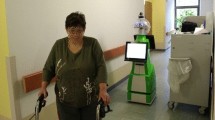Abstract
This paper proposes a robot design which combines an unobtrusive presence around the household with a patient rehabilitation tool. The robot is envisaged to spend most of its time in standby mode, springing into action at pre-set times in order to engage the patient into taking a rehabilitation program. The rehabilitation tool guides the patient through a set series of prescribed repetitive physical exercises, provides feedback and keeps track of the patient’s progress, and finally summarises the feedback to a clinician who can supervise exercise uptake and effectiveness. We have achieved proof of this concept on two separate fronts which have been tested separately: an obstacle-avoidance robot which finds (and composes photographs of) people, and a stand-alone piece of software which displays and assesses physiotherapy exercises.
Access this chapter
Tax calculation will be finalised at checkout
Purchases are for personal use only
Similar content being viewed by others
References
iRobot Roomba http://www.irobot.co.uk
RITA—The Reliable Interactive Table Assistant http://www.assistobot.com/rita/en/
Zabarauskas, M.: Improving autonomous robot photography using RGB-D sensors. MSc thesis, Department of Computer Science, Oxford University (2013)
Kozlowski, P.: Measuring gesture mimicking accuracy with microsoft kinect, Fourth Year Project, Department of Computer Science, Oxford University (2013)
iClebo Kobuki http://kobuki.yujinrobot.com/home-en/
Viola, P. and M. Jones.: Rapid object detection using a boosted cascade of simple features. In: Proceedings of IEEE Computer Society Conference on Computer Vision and Pattern Recognition (2001)
Zabarauskas, M., Cameron: Luke, S.: An Autonomous robot photographer. In: Proceedings of ICRA (2014)
Vaughan, R., Sumpter, N., Henderson, J., Frost, A., Cameron, S.: Experiments in automatic flock control. Robot Auton Syst 31, 109–117 (2000)
Royal Society Summer Science Exhibition https://royalsociety.org/summer-science/
Bickerton, W.-L., et al.: Systematic assessment of apraxia and functional predictions from the Birmingham Cognitive Screen. J Neurol Neurosurg Psychiatry 83, 513–521 (2012)
Catuhe, L.: Gestures and tools for kinect (2011)
Ahn, D. et al.: Robot photographer with user interactivity. In: Proceedings of Intelligent Robots and Systems, pp. 5637–5643 (2006)
Intel RealSense, http://intel.com/RealSense
Kiper, P., et al.: Reinforced feedback in virtual environment for rehabilitation of upper extremity dysfunction after stroke: preliminary data from a randomized controlled trial. Biomed. Res. Int. (2014). doi:10.1155/2014/752128
Kwakkel, G. et al.: Effects of robot-assisted therapy on upper limb recovery after stroke: a systematic review. Clin Neurol. (2014)
Acknowledgements
We are grateful to Prof Glyn Humphrey’s insights on apraxia-related gestures and to Dr Mihaela Duta for system feedback and data collection.
Author information
Authors and Affiliations
Corresponding author
Editor information
Editors and Affiliations
Rights and permissions
Copyright information
© 2016 Springer International Publishing Switzerland
About this paper
Cite this paper
Voiculescu, I., Cameron, S., Zabarauskas, M., Kozlowski, P. (2016). Towards Robot-Assisted Rehabilitation of Upper Limb Dysfunction. In: Borangiu, T. (eds) Advances in Robot Design and Intelligent Control. Advances in Intelligent Systems and Computing, vol 371. Springer, Cham. https://doi.org/10.1007/978-3-319-21290-6_35
Download citation
DOI: https://doi.org/10.1007/978-3-319-21290-6_35
Published:
Publisher Name: Springer, Cham
Print ISBN: 978-3-319-21289-0
Online ISBN: 978-3-319-21290-6
eBook Packages: EngineeringEngineering (R0)




